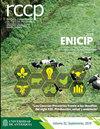透明质酸和醋酸曲安奈德单独或联合对间充质干细胞成软骨分化的潜在影响
IF 0.5
4区 农林科学
Q4 AGRICULTURE, DAIRY & ANIMAL SCIENCE
引用次数: 0
摘要
背景:骨关节炎是一种复杂的退行性疾病,有多种因素导致关节损伤。目的:比较透明质酸(HA)和曲安奈德(TA)单独或联合使用对间充质干细胞(MSCs)体外成软骨分化过程的潜在影响。方法:将MSCs分为对照组、HA组、TA组、HA/TA联合组。各组在软骨分化培养基中培养14 d。采用组织学和免疫组织化学方法评估成软骨分化潜能。结果:HA和HA/ ta处理的MSCs表现出与天然软骨细胞相似的组织学特征。ta处理的MSCs细胞外基质(ECM)致密且有组织。对照组糖胺聚糖染色强烈,TA染色中等,HA/TA染色轻微,HA染色未检出。在ta处理的ECM和MSCs中,II型胶原免疫反应性较高。结论:组织学分析表明,透明质酸对MSCs软骨细胞形态发育的影响类似于软骨细胞,但特异性软骨分子的表达较低。TA促进形成一个紧凑和有组织的ECM。本文章由计算机程序翻译,如有差异,请以英文原文为准。
Potential effect of hyaluronic acid and triamcinolone acetate, alone or combined, on chondrogenic differentiation of mesenchymal stem cells
Background: Osteoarthritis is a complex degenerative disease with several factors contributing to joint damage. Objective: To compare the potential effect of hyaluronic acid (HA) and triamcinolone acetonide (TA), alone or combined, on the in vitro chondrogenic differentiation process of mesenchymal stem cells (MSCs). Methods: MSCs were divided into four groups: Control, HA, TA, and HA/TA combined. Each treatment group was cultured for 14 days in chondrogenic differentiation medium. The chondrogenic differentiation potential was assessed by histology and immunohistochemistry. Results: The HA and HA/TA-treated MSCs presented histological characteristics similar to native chondrocytes. The extracellular matrix (ECM) of TA-treated MSCs was compact and organized. Glycosaminoglycan staining was intense in Control, moderate in TA, slight in HA/TA, and undetectable in HA. Type II collagen immunoreactivity was high in the TA-treated ECM and MSCs. Conclusions: Histological analysis shows that HA influences morphological development similar to chondrocytes of the MSCs, but with low expression of specific cartilage molecules. The TA promotes formation of a compact and organized ECM.
求助全文
通过发布文献求助,成功后即可免费获取论文全文。
去求助
来源期刊

Revista Colombiana De Ciencias Pecuarias
AGRICULTURE, DAIRY & ANIMAL SCIENCE-
CiteScore
0.80
自引率
0.00%
发文量
18
审稿时长
6-12 weeks
期刊介绍:
The editors of Revista Colombiana de Ciencias Pecuarias (RCCP) welcome the submission of original manuscripts on experimental and clinical studies associated with the broad areas of animal sciences and veterinary medicine as they interface with biochemistry, molecular biology, physiology, pharmacology, toxicology, pathology, microbiology, parasitology, immunology and epidemiology. The scope of the journal includes studies of basic and applied research in animal management and production, feeding and nutrition, reproduction, breeding, genetics, animal welfare and behavior; as well as animal production focussed from biotechnology, soil science, agrostology, silvopastoral systems, livestock economics and the environment.
The criteria for acceptance of papers submitted for publication are originality, quality and clarity of the content. Each contribution must be based on original, unpublished research that has not been simultaneously submitted to other journals. All papers will be peer reviewed. All authors bear responsibility for ensuring the integrity and quality of their reported research. It is the author''s responsibility to secure permission to use figures or tables that have been published elsewhere.
Contributions may be classified as original research, review, rapid communication, clinical case studies or methodological articles, as well as news/commentaries or letters to the editor. Most review articles are invited by the editor. Authors interested in submitting a review article should contact the corresponding editor. Rapid publication of original manuscripts is a goal of the journal. Manuscripts must be written in English. Each manuscript is considered for publication with the understanding that it has not been simultaneously submitted to any other journal. Upon acceptance for publication, papers are subject to editorial review and revision.
 求助内容:
求助内容: 应助结果提醒方式:
应助结果提醒方式:


